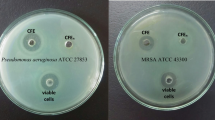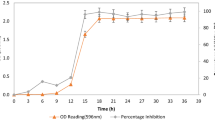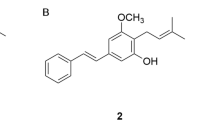Abstract
This study aimed to elucidate the targets and mechanisms of anti-staphylococcal effects from bioactive metabolites produced by lactic acid bacteria. We aimed to better understand the safety and efficacy of these bioactive metabolites in in vivo systems, typically at topical sites. The cell-free supernatant and protein-rich fraction from Lactobacillus plantarum USM8613 inhibited staphyloxanthin biosynthesis, reduced (p < 0.05) the cell number of Staphylococcus aureus by 106 CFU/mL and reduced biofilm thickness by 55% in S. aureus-infected porcine skins. Genome-wide analysis and gene expression analysis illustrated the production of several plantaricins, especially the plantaricins EF and JK that enhanced the anti-staphylococcal effects of L. plantarum USM8613. In vivo data using rats showed that the protein-rich fraction from L. plantarum USM8613 exerted wound healing properties via direct inhibition of S. aureus and promoted innate immunity, in which the expression of β-defensin was significantly (p < 0.05) upregulated by 3.8-fold. The protein fraction from L. plantarum USM8613 also significantly enhanced (p < 0.05) the production of cytokines and chemokines through various stages of wound recovery. Using ∆atl S. aureus, the protein-rich fraction from L. plantarum USM8613 exerted inhibitory activity via targeting the atl gene in S. aureus. Taken altogether, our present study illustrates the potential of L. plantarum USM8613 in aiding wound healing, suppressing of S. aureus infection at wound sites and promoting host innate immunity.










Similar content being viewed by others
References
Amini R, Sahib AA, Wong CB, Jahansiri F, Chung C, Hematian A, Sekawi Z, Jalilian FA (2013) Identification and screening of methicillin-resistant Staphylococcus aureus from fingernails among university students in Malaysia. Asia Life Sci 22:323–340
Chavakis T, Hussain M, Kanse SM, Peter G, Bretzel RG, Flock JI, Herrmann M, Preissner KT (2002) Staphylcoccus aureus extracellular adherence protein (Eap) serves as anti-inflammatory factor by inhibiting the recruitment of host leukocytes. Nat Med 8:687–693
Lee LY, Miyamoto YJ, Mclntyre BW, Höök M, McCrea KW, McDevitt D, Brown EL (2002) The Staphylococcus aureus Map protein is an immunomodulator that interferes with T cell mediated responses. J Clin Invest 110:1461–1471
Foster TJ (2005) Immune evasion by staphylococci. Nat Rev Microbiol 3:948–958
Jay J (2000) Fermentation and fermented dairy products. In: Jay J (ed) Modern food microbiology. Aspen Food Science Text Series. Springer US, New York, pp 113–130
Holzapfel WH, Haberer P, Geisen R, Björkroth J, Schillinger U (2001) Taxonomy and important features of probiotic microorganisms in food and nutrition. Am J Clin Nutr 73:365s–373s
Kalliomäki M, Salminen S, Poussa T, Isolauri E (2007) Probiotic during the first 7 years of life: a cumulative risk reduction of eczema in a randomised, placebo-controlled trial. J Allergy Clin Immunol 119:1019–1021
Kalliomäki M, Salminen S, Poussa T, Arvilommi H, Isolauri E (2003) Probiotics and prevention of atopic disease: 4-year follow-up of a randomized placebo-controlled trial. Lancet 361:1869–1871
Gillor O, Etzion A, Riley MA (2008) The dual role of bacteriocins as anti-and probiotics. Appl Microbiol Biotechnol 81:591–606
Havarstein LS, Diep DB, Nes IF (1995) A family of bacteriocin transporters carry out proteolytic processing of their substrates concomitant with export. Mol Microbiol 16:229–240
de Arauz LJ, Jozala AF, Mazzola PG, Penna TCV (2009) Nisin biotechnological production and application: a review. Trends Food Sci Technol 20:146–154
Amariei G, Kokol V, Boltes K, Leton P, Rosal R (2018) Incorporation of antimicrobial peptides on electrospun nanofibres for biomedical applications. RSC Adv 8:28013–28023
Najjari A, Ouzari H, Boudabous A, Zagorec M (2008) Method for reliable isolation of Lactobacillus sakei strains originating from Tunisian seafood and meat products. Int J Food Microbiol 121:342–351
Ivanova I, Kabadjova P, Pantev A, Danova S, Dousset X (2000) Dectection, purification and partial characterization of a novel bacteriocin substance produced by Lactococcus lactis subsp. lactis B14 isolated from boza-Bulgarian traditional cereal beverage. Photonics Nanostruct Fundam Appl 41:47–53
Bradford MM (1976) A rapid and sensitive method for the quantitation of microgram quantities of protein utilising the principle of protein-dye binding. Anal Biochem 72:248–254
Romero-Tabarez M, Jansen R, Sylla M, Lunsdorf H, Häußler S, Santosa DA, Timmis KN, Molinari G (2006) 7-O-malonyl macrolactin A, a new macrolactin antibiotic from Bacillus subtilis active against methicillin-resistant Staphylococcus aureus, vancomycin-resistant enterococci, and a small-colony variant of Burkholderia cepacia. Antimicrob Agents Chemother 50:1701–1709
Liu CI, Liu GY, Song Y, Yin F, Hensler ME, Jeng WY, Nizet V, Wang AH, Oldfield E (2008) A cholesterol biosynthesis inhibitor blocks Staphylococcus aureus virulence. Science 319(5868):1391–1394
Heydorn A, Nielsen AT, Hentzer M, Sternberg C, Givskov M, Ersboll BK, Molin S (2000) Quantification of biofilm structures by the novel computer program COMSTAT. Microbiology 146:2395–2407
Sasidharan S, Logeswaran S, Latha LY (2012) Wound healing activity of Elaeis guineensis leaf extract ointment. Int J Mol Sci 13:336–347
Van Loosdrecht MCM, Lyklema J, Norde W, Zehnder AJ (1990) Influence of interfaces on microbial activity. Microbiol Rev 54:75–87
Clauditz A, Resch A, Wieland KP, Peschel A, Götz F (2006) Staphyloxanthin plays a role in the fitness of Staphylococcus aureus and its ability to cope with oxidative stress. Infect Immun 74:4950–4953
Lauderdale KJ, Boles BR, Cheung AL, Horswill AR (2009) Interconnection between sigma B, agr, and proteolytic activity in Staphylococcus aureus biofilm maturation. Infect Immun 77(4):1623–1635
Nissen-Meyer J, Rogne P, Oppegard C, Haugen HS, Kristiansen PE (2009) Structure-function relationships of the non-lantionine-containing peptide (classII) bacteriocins produced by Gram-positive bacteria. Curr Pharm Biotechnol 10:19–37
Anderssen EL, Diep DB, Nes IF, Eijsink VG, Nissen-Meyer J (1998) Antagonistic activity of Lactobacillus plantarum C11: new two-peptide bacteriocins, plantaricins EF and JK, and the induction factor plantaricin A. Appl Environ Microbiol 64:2269–2272
Akdis M, Burgler S, Crameri R, Eiwegger T, Fujita H, Gomez E, Klunker S, Meyer N, O’Mahony L, Palomares O, Rhyner C, Quaked N, Schaffartzik A, Van de Veen W, Zeller S, Zimmemann M, Akdis CA (2011) Interleukins, from 1 to 37, and interferon- Ɣ: receptors, functions, and roles in diseases. J Allergy Clin Immunol 127:701–721
Froy O, Hananel A, Chapnik N, Madar Z (2005) Differential expression of rat β-defensins. IUMBM Life 57(1):41–43
Steenfos HH, Hunt TKL, Scheuenstuhl H, Goodson WHIII (1989) Selective effects of tumour necrosis factor-alpha on wound healing in rats. Surgery 106:171–176
Ishida Y, Kondo T, Takayasu T, Iwakura Y, Mukaida N (2004) The essential involvement of cross-talk between IFN- Ɣ and TGF- β in the skin wound healing process. J Immunol 172:1848–1855
Gutiérrez-Fernández A, Inada M, Balbín M, Fueyo A, Pitiot AS, Astudillo A, Hirose K, Hirata M, Shapiro SD, Noël A, Werb Z, Krane SM, López-Otín C, Puente XS (2007) Increased inflammation delays wound healing in mice deficient in collagenase-2 (MMP-8). FASEB J 21:2580–2591
Biswas R, Voggu L, Simon UK, Hentschel P, Thumm G, Gotz F (2006) Activity of the major staphylococcal autolysin Atl. FEMS Microbiol Lett 259:260–268
Sugai M, Yamada S, Nakashima S, Komatsuzawa H, Matsumoto A, Oshida T, Suginaka H (1997) Localised peroration of the cell wall by a major autolysin: atl gene products and the onset of penicillin-induced lysis of Staphylococcus aureus. J Bacteriol 179:2958–2962
Trotonda MP, Xiong YQ, Memmi G, Bayer AS, Cheung AL (2009) The role of mgrA and sarA in autolysis and resistance to cell-wall-active antibiotics in methicillin-resistant Staphylococcus aureus. J Infect Dis 199:209–218
Truong-Bulduc QC, Hooper DC (2010) Phosphorylation of mgrA and its effect on expression of the norA and norB efflux pumps of Staphylococcus aureus. J Bacteriol 192:2525–2534
Cheung GYC, Wang R, Khan BA, Sturdevant DE, Otto M (2011) Role of the accessory gene regulator agr in community-associated methicillin-resistant Staphylococcus aureus pathogenesis. Infect Immun 79:1927–1935
Rice KC, Patton JB, Yang S-J, Dumoulin A, Bischoff M, Bayles KW (2004) Transcription of the Staphylococcus aureus cidABC and lrg murein hydrolase regulators is affected by sigma factor B. J Bacteriol 186:3029–3037
Yang SJ, Rice KC, Brown RJ, Patton TG, Liuo LE, Park YH, Bayles KW (2005) A Lys-type regulator, CidR, is required for induction of the Staphylococcus aureuscidABC operon. J Bacteriol 187:5893–3900
Acknowledgements
The Δatl S. aureus strain was kindly provided by Prof. Dr. Hiroshi Ohno from the RIKEN Center for Integrative Medical Sciences (Japan).
Funding
This research was funded by the USM-RIKEN International Centre for Ageing Science (URICAS) grant (1001/PEKIND/870030).
Author information
Authors and Affiliations
Contributions
Ohno H and Liong MT designed the experiments. JS Ong, Yong CC, Khoo BY, Sasidharan S and Choi SB performed the analyses. Taylor TD, JS Ong, Yong CC, Ohno H and Liong MT wrote the manuscript.
Corresponding authors
Ethics declarations
The experimental protocol for treating animals was approved and in accordance with the guidelines recommended by the USM Committee on Animal Care; reference number: USM/Animal Ethics Approval/2012/(81)(433).
Competing Interests
The authors declare that they have no competing interests.
Additional information
Publisher’s Note
Springer Nature remains neutral with regard to jurisdictional claims in published maps and institutional affiliations.
Electronic supplementary material
ESM 1
(DOCX 613 kb)
Rights and permissions
About this article
Cite this article
Ong, J.S., Taylor, T.D., Yong, C.C. et al. Lactobacillus plantarum USM8613 Aids in Wound Healing and Suppresses Staphylococcus aureus Infection at Wound Sites. Probiotics & Antimicro. Prot. 12, 125–137 (2020). https://doi.org/10.1007/s12602-018-9505-9
Published:
Issue Date:
DOI: https://doi.org/10.1007/s12602-018-9505-9




